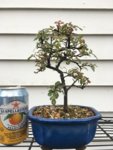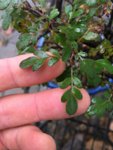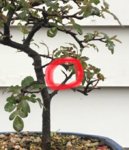Mike Hennigan
Chumono
I managed to stop by New England Bonsai Gardens on my thanksgiving travels and picked up three trees. I was really impressed by their selection and the quality of the trees and prices were pretty reasonable. Besides an azalea and a Korean hornbeam, I pick up this little “Dwarf Hawthorn”. I was very intrigued, I had never heard of a dwarf hawthorn before and hawthorns are one of my favorite deciduous. I couldn’t pass this little guy up. Now, I didn’t buy it because th tree was impressive, but I plan to put it into a larger grow box and beef him up a bit and then propagate with cuttings or air layers down the line.
The thing is I have no idea what this tree actually is. The tag said “dwarf hawthorn” and the species name that was written was Crataegus oxyacantha. If you google that species name you will find that it was once used to describe multiple species of Northern European hawthorn, and now is a rejected species name no longer used. None of those species that fall under that umbrella have leaves like this, which are much more of a compound leaf. Now, I know that when dwarf varieties are born the leaves can change a lot from their parent species. I was able to find one picture of this variety as bonsai but no real info attached to it.
If anybody has any insight into what species this variety actually is or any other info on it, I would greatly appreciate it. The main thing I’m worried about is if it actually is cold hardy to my zone in upstate NY, and safe to overwinter outside, though they assured me it would be fine.




The thing is I have no idea what this tree actually is. The tag said “dwarf hawthorn” and the species name that was written was Crataegus oxyacantha. If you google that species name you will find that it was once used to describe multiple species of Northern European hawthorn, and now is a rejected species name no longer used. None of those species that fall under that umbrella have leaves like this, which are much more of a compound leaf. Now, I know that when dwarf varieties are born the leaves can change a lot from their parent species. I was able to find one picture of this variety as bonsai but no real info attached to it.
If anybody has any insight into what species this variety actually is or any other info on it, I would greatly appreciate it. The main thing I’m worried about is if it actually is cold hardy to my zone in upstate NY, and safe to overwinter outside, though they assured me it would be fine.




Last edited:




